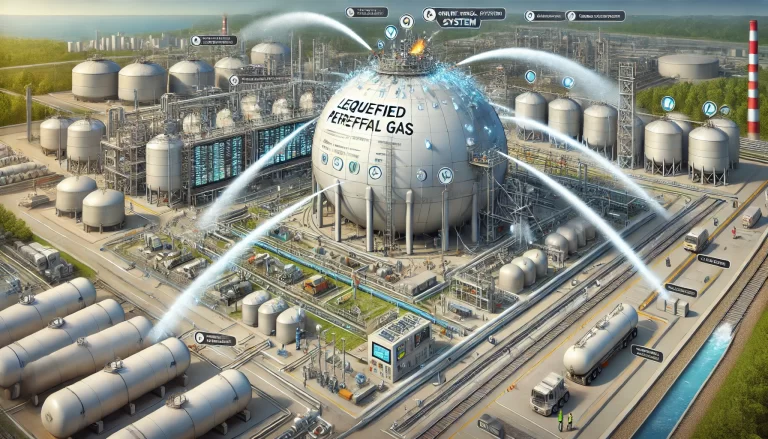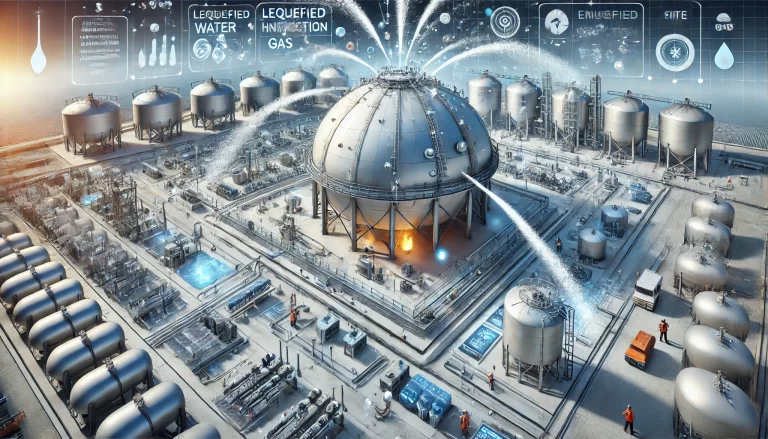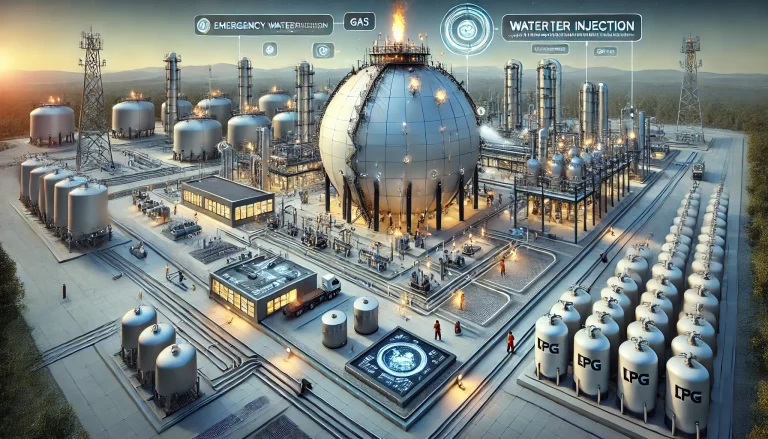Introduction
Liquefied hydrocarbon spherical tanks are widely used in the petrochemical industry for the storage of highly volatile and flammable substances such as liquefied petroleum gas (LPG), propane, and butane. Ensuring the safety of these tanks is critical, particularly in emergency situations such as fires or leaks. One essential safety measure is the emergency water injection system, which cools the tank surface, prevents catastrophic failures, and reduces vapor release. However, the reliability and effectiveness of these systems must be continually improved to ensure optimal performance under emergency conditions. This article explores strategies for enhancing the design, equipment reliability, automation, operational management, and maintenance of emergency water injection systems.
1. Optimizing System Design
1.1 Ensuring Comprehensive Water Coverage
A well-designed emergency water injection system must provide uniform cooling across the entire spherical tank surface. Key design considerations include:
Strategic nozzle placement: Install high-coverage spray nozzles to ensure uniform cooling, with a particular focus on the top and high-heat exposure areas.
Adjustable spray angles: Use flexible or multi-directional nozzles to maximize coverage and prevent dry spots.
Multiple injection zones: Implement independent water injection zones to allow for selective activation based on the tank’s heat exposure and risk levels.

1.2 Reliable Water Supply System
To maintain a consistent and reliable water supply, the following strategies should be adopted:
Dual water sources: Utilize both municipal water supply and dedicated firefighting water reservoirs to ensure continuous availability.
High-capacity water storage tanks: Install reserve tanks with sufficient capacity to sustain prolonged emergency cooling operations.
Elevated water tanks or pressure stabilization systems: Prevent interruptions in water supply due to pump failures or pressure drops.
1.3 Integration of Smart Control Systems
Modernizing the emergency water injection system with smart control features improves response time and operational efficiency:
Automated activation triggers: Connect the system to fire detection and gas leak sensors to enable automatic activation during emergencies.
Remote monitoring capabilities: Utilize programmable logic controllers (PLCs) and distributed control systems (DCS) to enable remote operation and monitoring.
Data logging and trend analysis: Implement real-time data collection and analysis to optimize performance and detect potential failures before they occur.
2. Enhancing Equipment Reliability
2.1 Selecting High-Performance Pumps and Valves
To ensure system readiness, high-quality components should be used:
Corrosion-resistant materials: Use stainless steel or specialized alloys for pipes, pumps, and valves to withstand harsh environments.
Redundant pumping systems: Install backup pumps to prevent system failure in case of primary pump malfunction.
Pressure-regulated pumps: Ensure stable water flow and pressure to maintain effective spray coverage.
2.2 Strengthening Pipeline Durability
The reliability of the pipeline network is crucial for uninterrupted water delivery:
Use of durable, anti-corrosion piping: Opt for galvanized steel, coated iron, or HDPE piping to prevent rusting and clogging.
Periodic pressure tests: Conduct regular hydrostatic testing to verify pipeline integrity and detect leaks early.
Thermal insulation in cold climates: Prevent freezing and blockages in low-temperature environments by using insulated pipes.

3. Increasing Automation and Smart Monitoring
3.1 Implementing Remote Control Systems
Modern emergency water injection systems should be equipped with automation to improve response time and efficiency:
Real-time pressure and flow rate sensors: Continuously monitor system performance to ensure adequate water distribution.
Remote-controlled activation: Allow system activation from a central control room to eliminate delays caused by manual operation.
SCADA integration: Enable supervisory control and data acquisition (SCADA) to provide comprehensive monitoring and control.
3.2 Utilizing AI and IoT for Predictive Maintenance
Artificial intelligence (AI) and the Internet of Things (IoT) can enhance system reliability by:
Predicting equipment failures: AI-based analysis of sensor data can identify early signs of pump or valve failures.
Scheduling maintenance proactively: IoT-enabled alerts can notify operators when preventive maintenance is required.
Reducing false alarms: Advanced pattern recognition can differentiate between genuine emergencies and sensor malfunctions.
4. Strengthening Operational Management
4.1 Establishing Standard Operating Procedures (SOPs)
Clear and detailed SOPs should be developed to guide personnel in emergency situations:
Defined activation criteria: Specify when and how the system should be triggered based on fire severity and risk assessment.
Step-by-step response protocols: Ensure operators understand the sequence of actions needed for effective emergency response.
Emergency drills and training: Conduct regular hands-on training to improve response time and personnel familiarity with the system.
4.2 Conducting Periodic System Drills and Testing
To ensure system readiness, regular testing should be performed:
Monthly functional tests: Activate the system periodically to check pump functionality and nozzle performance.
Annual full-scale simulations: Conduct large-scale emergency response drills involving all safety systems and personnel.
Data analysis from test results: Use historical performance data to identify weaknesses and make necessary system improvements.

5. Strengthening Maintenance and Inspection Procedures
5.1 Preventing System Blockages and Corrosion
Regular maintenance is critical to ensure water flow remains unobstructed:
Routine flushing of pipes and nozzles: Prevent clogging caused by sediment accumulation.
Anti-corrosion treatments: Apply protective coatings and perform periodic inspections to detect rust formation.
Water quality control: Ensure that stored water does not contain contaminants that may lead to scaling or microbial growth.
5.2 Stocking Spare Parts and Emergency Repair Kits
Maintaining an inventory of essential spare parts minimizes downtime in case of failures:
Backup pumps, valves, and sensors: Keep key components readily available for quick replacement.
Portable emergency repair kits: Equip field teams with tools and spare parts to conduct on-the-spot repairs.
Dedicated maintenance team: Assign skilled personnel to conduct regular inspections and respond to emergencies promptly.

Conclusion
The emergency water injection system plays a crucial role in ensuring the safety of liquefied hydrocarbon spherical tanks. By optimizing system design, enhancing equipment reliability, increasing automation, strengthening operational management, and improving maintenance practices, its reliability and effectiveness can be significantly enhanced. Continuous investment in modern technology, regular training, and proactive maintenance will ensure that these systems function optimally in critical situations, reducing the risk of catastrophic incidents in the petrochemical industry.
